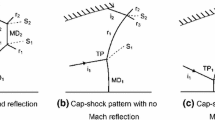Abstract
During development tests of the LE-7A prototype engine, severe side-loads were observed. The side-load peaks appeared only in certain limited conditions during start-up and shut-down transients. To investigate phenomena causing those severe side-loads observed in the LE-7A prototype engine nozzle, series of cold-flow tests and hot-firing tests as well as CFD analyses were conducted. As a result of the hot-firing tests, two different phenomena were found to cause severe side-loads in the LE-7A prototype engine nozzle. One was a restricted shock separation (RSS) flow structure and the other was a phenomenon termed “separation jump,” the rapid movement of the separation location in the vicinity of the step. A step was installed in the LE-7A prototype to supply film-cooling gas. Hot-firing test results showed that RSS can occur for a limited mixture ratio. Detailed flow structure of RSS on the nozzle surface was revealed by the cold-flow tests. Measured pressures and visualized images of cold-flow tests clarified the mechanism causing the separation jump. The key phenomenon ruling the separation jump was found to be the base flow behind the step. Based on the results of the present study, the latest LE-7A engine nozzle design has been changed to eliminate the severe side-load.
Similar content being viewed by others
Abbreviations
- X :
-
Axial location from throat
- R :
-
Radius of nozzle contour for each axial location
- r*:
-
Radius at throat
- θ e :
-
Nozzle exit angle
- L N :
-
Nozzle length
- C CTP :
-
Compression factor of CTP nozzle
- P c :
-
Combustion chamber pressure of hot-firing tests or plenum pressure of cold-flow tests
- P a :
-
Ambient pressure
- \({P_{{\rm n}_i}}\) :
-
Nozzle wall pressure measured at ith pressure port from the throat
- M e :
-
Nozzle exit Mach number
- NPR:
-
Nozzle pressure ratio, P c/P a
- NPRsep :
-
NPR at which separation take place at each location
- O/F :
-
Mixture ratio, ratio of weight of the oxidizer and that of the fuel
References
Watanabe, Y., et al.: LE-7A Engine Nozzle Problems during the Transient Operations. AIAA Paper 2002–4001 (2002)
Schmucker, R.: Flow Process in Overexpanded Chemical Rocket Nozzles. Part 1: Flow Separation. NASA TM-77396 (1984)
Terhardt, M., et al.: Flow Separation and Side-load Behavior of the Vulcain Engine. AIAA Paper 97–2762 (1997)
Dumnov, G.E., et al.: Unsteady Side-loads Acting on the Nozzle with Developed Separation Zone. AIAA Paper 96–3220 (1996)
Frey, M., Hagemann, G.: Status of Flow Separation Prediction in Rocket Nozzles. AIAA Paper 98-3619 (1998)
Frey, M., Hagemann, G.: Flow Separation and Side-load in Rocket Nozzles. AIAA Paper 99-2815 (1999)
Frey M., Hagemann G. (2000) Restricted Shock Separation in Rocket Nozzles. Journal of Propulsion and Power 16: 478–484
Rao, G.V.R.: Exhaust Nozzle Contour for Optimum Thrust. Jet Propulsion, June, pp. 377–382 (1958)
Tomita, T., et al.: Visualization of the Formation of Separation Bubbles on a Bell-shaped Nozzle Surface in Relation to Serious Side-load. AIAA Paper 2001–3559 (2001)
Tomita, T., et al.: Parametric Study on the Influence of a Discontinuous Step in a Nozzle Contour on Side-load. AIAA Paper 2003–4764 (2003)
Tomita, T., et al.: Strong Side-Load Observed on a Parabolic Nozzle with No RSS Flow Pattern. AIAA Paper 2005–3941 (2005)
Tomita, T., et al.: Investigation of cause of side-load on LE-7A engine with combustion tests using an LE-7A subscale combustor. In: Proceedings of the 23rd ISTS (2002)
Tomita, T., et al.: Subscale Nozzle Combustion Tests of the LE-7A Engine for Clarification of Large Side-load (I)—Formation of RSS Structure Due to Combustion Condition. AIAA Paper 2002–3842 (2002)
Tomita, T., et al.: Subscale Nozzle Combustion Tests of the LE-7A Engine for Clarification of Large Side-Loads (II)—Influence of a Step in Nozzle Contour on Side-Load. AIAA Paper 2002–4002 (2002)
Tomita, T., et al.: Relation Between Design Parameters of Rocket Nozzles and Phenomena Which Generate Severe Side-load. ISTS 2004-a-09 (2004)
Tomita, T., et al.: Experimental Evaluation of Side-load Characteristics on TP, CTP and TO nozzles. AIAA Paper 2004–3678 (2004)
Takahashi, M., et al.: Transient Flow Simulation of a Compressed Truncated Perfect Nozzle. AIAA Paper 2001–3681 (2001)
Takahashi, M., et al.: Influence of a Gap for Film Cooling on Transient Flow Characteristics of Rocket Engine Nozzle. AIAA Paper 2002–4147 (2002)
Hoffman, J.D.: Design of Compressed Truncated Perfect Nozzles. AIAA Paper 85-1172 (1985)
Gordon, S., McBride, B.J.: Computer Program for Calculation of Complex Chemical Equilibrium Composition and Applications. NASA RP-1311 (1994)
Author information
Authors and Affiliations
Corresponding author
Additional information
Communicated by A. Hadjadj.
Rights and permissions
About this article
Cite this article
Tomita, T., Takahashi, M., Sasaki, M. et al. Experimental evaluation of side-loads in LE-7A prototype engine nozzle. Shock Waves 19, 213–228 (2009). https://doi.org/10.1007/s00193-009-0191-0
Received:
Revised:
Accepted:
Published:
Issue Date:
DOI: https://doi.org/10.1007/s00193-009-0191-0




